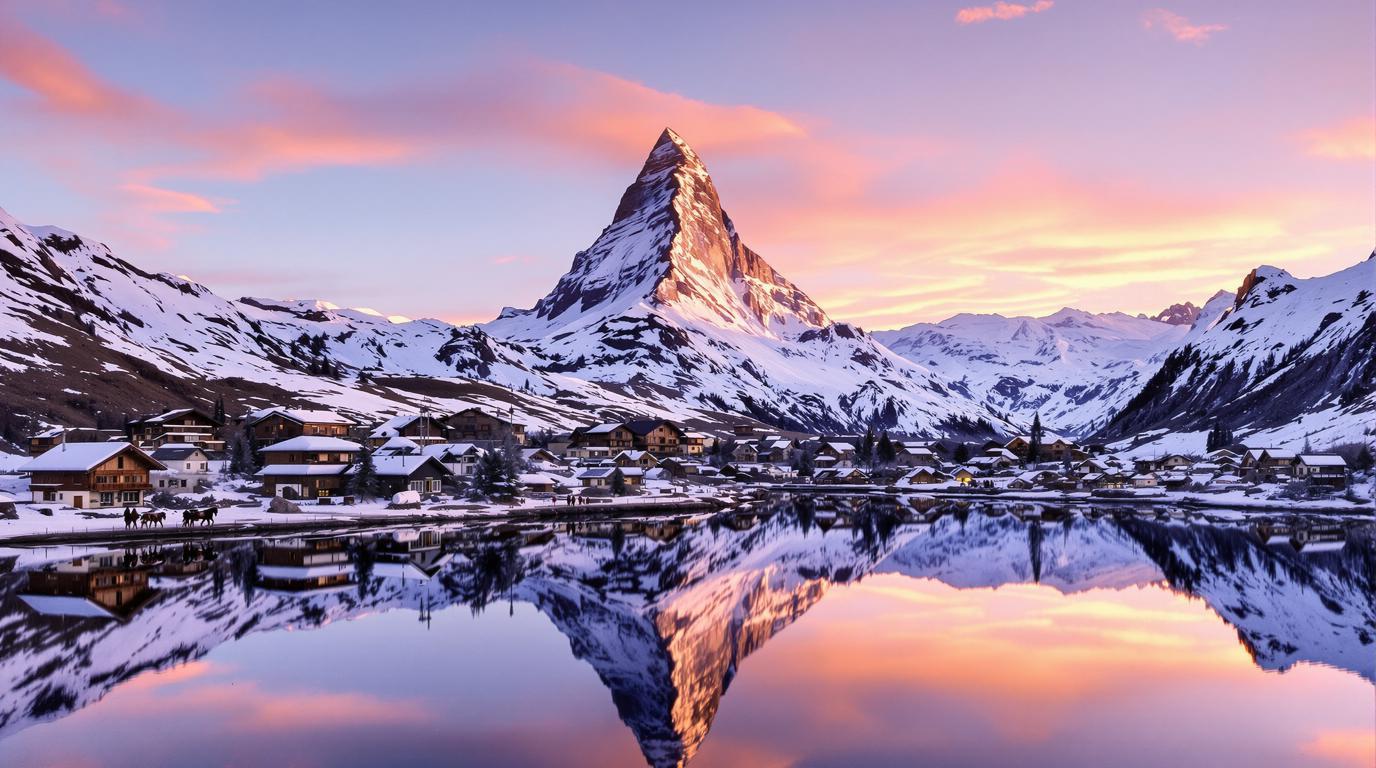The Matterhorn’s iconic pyramid silhouette cuts through the alpine sky like nature’s own monument, drawing visitors from across the globe to witness its majesty firsthand. Standing at the coordinates 45.9763° N, 7.6586° E, this 14,692-foot alpine sentinel towers over Zermatt, a charming car-free village that serves as the gateway to Switzerland’s most photographed mountain.
The mountain that shaped a nation’s identity
While Switzerland boasts numerous peaks, none has become as synonymous with the nation’s identity as the Matterhorn. First conquered in 1865 by British climber Edward Whymper, the mountain’s dramatic ascent ended in tragedy when four of his seven-member party perished during the descent. This event, rather than deterring adventurers, cemented the Matterhorn’s reputation as the ultimate alpine challenge.
The Matterhorn doesn’t just dominate our skyline—it dominates our soul. When visitors look up at that perfect peak, they understand something about Swiss precision and perfection that words could never explain,” shares Johann Weber, a third-generation mountain guide from Zermatt.
Zermatt: The village that banned cars
Unlike many mountain destinations that have sacrificed charm for convenience, Zermatt remains steadfastly committed to its car-free status. Electric shuttles and horse-drawn carriages transport visitors through narrow streets lined with timber chalets and boutique shops. The absence of vehicle noise creates an atmosphere where the distant rumble of glaciers and the clang of cowbells provide the soundtrack.
This commitment to environmental preservation parallels other remarkable conservation efforts, like the wildlife sanctuary that transformed poachers into protectors, proving that sustainable tourism can succeed on multiple continents.
A tale of two seasons
Summer in Zermatt (June-September) transforms the region into a hiker’s paradise. Over 250 miles of trails crisscross alpine meadows, offering perspectives of the Matterhorn that range from distant panoramas to intimate close-ups. The reflection of the mountain in Riffelsee Lake ranks among photography’s most sought-after natural compositions.
Winter (December-March) brings world-class skiing across three interconnected areas with guaranteed snow thanks to 365-day glacier skiing. Unlike the French Alps’ concrete apartment blocks, Zermatt’s slope-side accommodations maintain traditional Swiss architectural elements with modern luxury amenities.
Five viewpoints, one legendary mountain
The Gornergrat Railway, Europe’s highest open-air cogwheel train, climbs to 10,135 feet for Switzerland’s most spectacular mountain panorama. This engineering marvel shares kinship with the alpine train journey crossing 291 bridges through equally dramatic landscapes.
For the ultimate perspective, the Matterhorn Glacier Paradise cable car ascends to 12,740 feet, offering views extending into Italy, France, and the distant Mont Blanc massif. The brave can step onto the glass-bottomed viewing platform for a heart-stopping downward vista.
Local delicacies beyond chocolate and cheese
While Switzerland’s culinary reputation centers on cheese and chocolate, Zermatt elevates Alpine dining with over 100 restaurants, including the mountain-top Chez Vrony, where traditional dishes like rösti (potato fritters) and air-dried beef come with million-dollar views.
We don’t just serve food here—we serve the spirit of the mountains. Our ingredients come from the same slopes that visitors hike and ski. The connection between plate and place is direct and undeniable,” explains Maria Julen, chef-owner of a family-run mountain restaurant.
Like the medieval French village with a castle carved into limestone cliffs, Zermatt demonstrates how history and landscape can intertwine to create an unforgettable cultural experience.
Finding solitude in Switzerland’s most popular destination
Despite welcoming over two million visitors annually, Zermatt offers surprising pockets of solitude. The Zmutt Valley, accessible via a gentle two-hour hike, features 400-year-old wooden houses and an ancient stone bridge where time seems suspended. Here, the Matterhorn reflects in the windows of weathered chalets instead of tourist selfies.
For those seeking paradisiacal isolation similar to that heart-shaped island near Tahiti, the lesser-known Schwarzsee (Black Lake) offers meditative mountain reflections with fraction of the crowds found at more accessible viewpoints.
Like that hidden paradise in Asia rivaling Africa’s best safaris, the Matterhorn presents different faces depending on your approach. Whether illuminated by alpenglow at sunrise or silhouetted against star-filled skies, this mountain doesn’t simply occupy space in the landscape—it commands reverence from all who stand in its shadow.
